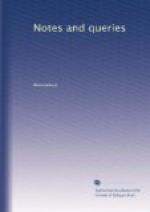Abbot’s House at Buckden (Vol. ii., p. 494.).—MR. C.H. COOPER asks, “will M.C.R. explain his allusion to the Abbot’s House at Buckden?” Being only an occasional visitor there, I can give no other explanation than it is universally called so by the inhabitants of the place. The house is very low-roomed, and only one story high; it has been compoed over, so that there is nothing very ancient in the look of the brickwork, excepting the chimneys, which form a cluster in the centre. The door I mentioned, evidently is an ancient one. A good deal of iron about it, and in square compartments.
When I was there recently, I was informed of a discovery in a public-house formerly called the Lion—now, the Lamb. A gentleman in the place came into possession of some pamphlets respecting Buckden; in one of which it is said, that this house was originally the hostel where the visitors and domestics used to go when the bishop had not room at the palace for them, and that it would be found there was an “Agnus Dei” in the ceiling of one of the lower rooms. The consequence was, search was made for it: and what seemed a plain boss, where two beams crossed each other, on being cleansed and scraped, turned out to be as the book said, and which I saw only last week. The clergyman has the pamphlet above alluded to. Whether this, and the abbot’s house, belonged to the palace I cannot say. The road now runs between them.
The “Agnus Dei” is seven or eight inches in diameter; the lamb, &c., in the centre, and the words “Ecce Agnus Dei” in a circular border round it.
This is all the information I can now give.
M.C.R.
Bab in the Bowster (Vol. ii., p. 518.).—In your valuable periodical your correspondent “MAC.” makes an observation regarding “Bab in the Bowster,” which is not correct so far as regards this part of the country at least. He says “it is now danced with a handkerchief instead of a cushion,” whereas the fact is I have never seen it danced but with a pillow, as its name “Bab in the Bowster (Anglice bolster)” would seem to denote. The manner of dancing it is, the company having formed itself into a circle, one, either male or female, goes into the centre, carrying a pillow, and dances round the circle with a sort of shuffling quick step, while the others sing,—
“Wha learn’d you to dance,
you to dance, you to dance,
Wha learn’d you to dance, Bab in
the Bowster brawly?”
To which the dancer replies:
“Mother learn’d me to dance,
me to dance, me to dance,
Mother learn’d me to dance, Bab
in the Bowster brawly.”
He or she then lays down the pillow before one of the opposite sex, when they both kneel on it and kiss; the person to whom the pillow has been presented going over the above again, &c, till the company tires.
I may add that the above is a favourite dance here, particularly among young people, and at children’s parties in particular it is never omitted. If your correspondent wishes the air to which it is danced, I shall be glad to send it to him.




